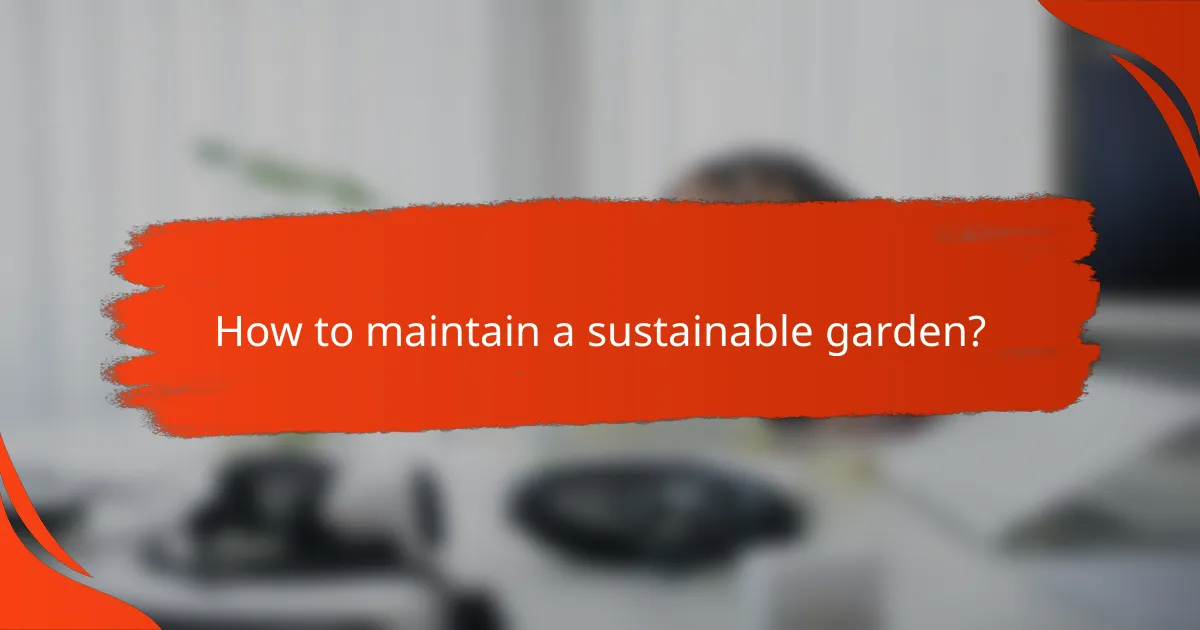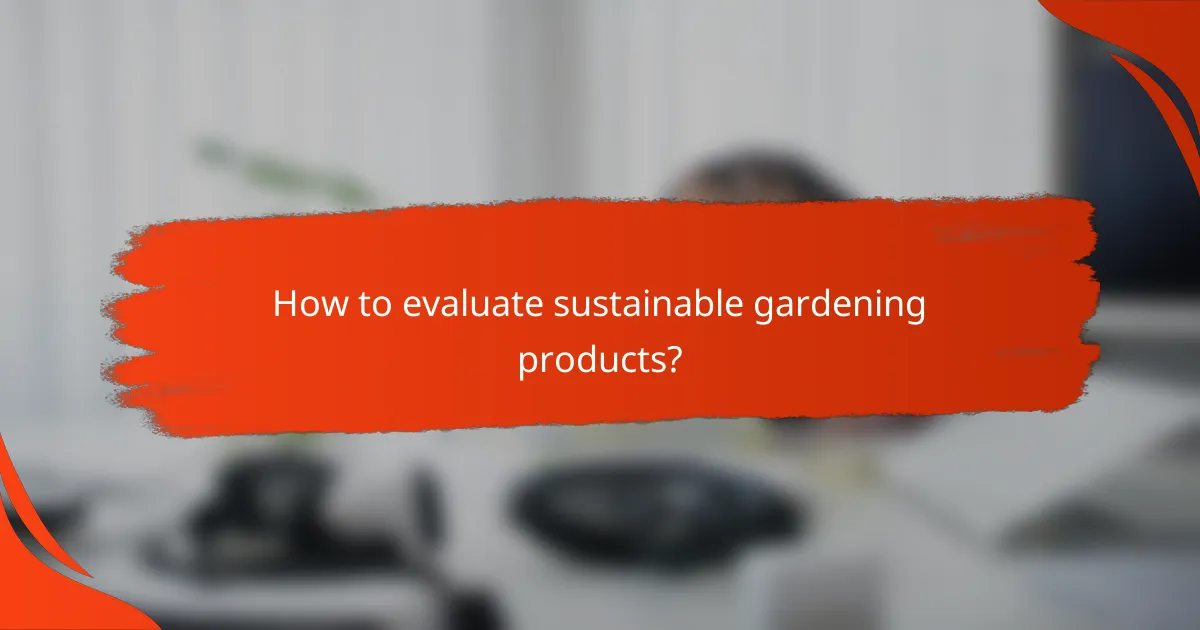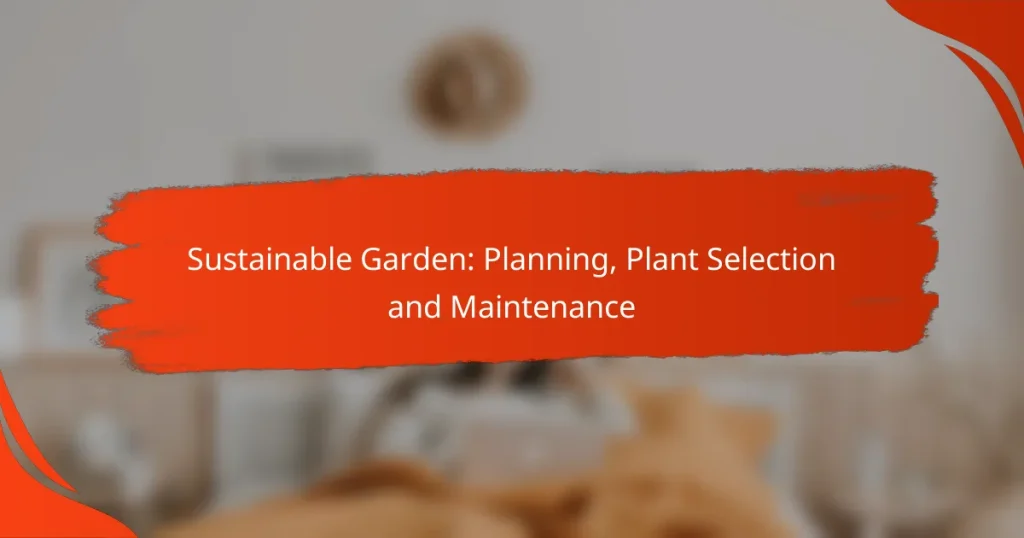Creating a sustainable garden requires careful planning, thoughtful plant selection, and ongoing maintenance to foster an eco-friendly environment. By choosing native species and perennials that thrive with minimal resources, you can support local ecosystems while maximizing the use of sunlight and water. Implementing practices such as organic pest control and water conservation will further enhance the health and resilience of your garden.

How to plan a sustainable garden in urban areas?
Planning a sustainable garden in urban areas involves assessing your space, selecting appropriate plants, and incorporating eco-friendly practices. Focus on maximizing resources like sunlight and water while minimizing waste to create a thriving environment.
Site assessment for sunlight and drainage
Begin by evaluating your garden’s sunlight exposure and drainage capabilities. Observe how many hours of direct sunlight your space receives daily, as most plants thrive with at least six hours. Additionally, check for areas where water tends to pool, as poor drainage can lead to root rot.
To improve drainage, consider installing raised beds or amending the soil with organic matter. This not only enhances drainage but also enriches the soil, promoting healthier plant growth.
Choosing native plants for local ecosystems
Selecting native plants is crucial for supporting local ecosystems and reducing maintenance. Native species are adapted to your region’s climate and soil, making them more resilient and less reliant on additional water or fertilizers.
Research local native plant nurseries or extension services to find suitable options. Incorporating a variety of plants can attract beneficial insects and pollinators, enhancing biodiversity in your urban garden.
Incorporating rainwater harvesting systems
Rainwater harvesting systems can significantly reduce water usage in your sustainable garden. Installing rain barrels to collect runoff from roofs allows you to store water for irrigation during dry spells.
Ensure your rainwater system complies with local regulations, as some areas have specific guidelines for collection and use. A simple setup can include a barrel with a spigot, connected to a downspout, making it easy to access stored water.
Utilizing vertical gardening techniques
Vertical gardening techniques are ideal for maximizing space in urban environments. By using trellises, wall planters, or hanging pots, you can grow a variety of plants without requiring extensive ground space.
Consider using vertical structures to grow climbing plants like beans or cucumbers, which can thrive in limited areas. This approach not only saves space but also adds visual interest to your garden.
Creating composting systems for waste reduction
Implementing a composting system helps reduce kitchen and garden waste while enriching your soil. Start with a simple compost bin or pile to collect organic materials like fruit scraps, vegetable peels, and yard waste.
Maintain your compost by regularly turning it to aerate and speed up decomposition. In urban areas, consider vermicomposting with worms to efficiently process organic waste in smaller spaces.

What plants are best for sustainable gardening?
Plants that are best for sustainable gardening are typically native species, perennials, and those that require minimal resources. These plants support local ecosystems, require less water and fertilizer, and can thrive in various conditions.
Top native plants for biodiversity
Native plants are crucial for promoting biodiversity as they provide habitat and food for local wildlife. Examples include coneflowers, black-eyed Susans, and milkweed, which attract pollinators like bees and butterflies. Incorporating these plants can enhance the resilience of your garden ecosystem.
When selecting native plants, consider your local climate and soil conditions. Research local flora to find species that are well-adapted to your area, ensuring they thrive with minimal maintenance.
Perennials vs. annuals for sustainability
Perennials are generally more sustainable than annuals because they return year after year, reducing the need for replanting and soil disturbance. They often require less water and fertilizer once established. Examples of sustainable perennials include lavender, hostas, and daylilies.
Annuals, while often vibrant and colorful, need to be replanted each year, which can lead to increased resource use. If you choose annuals, opt for varieties that are drought-resistant and suited to your local climate to minimize their environmental impact.
Edible plants that thrive in small spaces
For small gardens, consider growing compact edible plants such as herbs, cherry tomatoes, and salad greens. These plants can be cultivated in containers or vertical gardens, maximizing space while providing fresh produce. Herbs like basil and parsley are particularly well-suited for small areas.
Utilizing raised beds or vertical planters can further enhance your ability to grow food in limited space. Ensure you select varieties that are known for high yields in small areas to make the most of your gardening efforts.

How to maintain a sustainable garden?
Maintaining a sustainable garden involves practices that promote ecological balance and resource efficiency. Key aspects include organic pest control, water conservation, and soil health management.
Organic pest control methods
Organic pest control methods focus on using natural solutions to manage pests without harmful chemicals. Techniques include introducing beneficial insects, such as ladybugs and lacewings, which prey on common garden pests.
Another effective method is using homemade sprays made from ingredients like garlic or neem oil, which deter pests while being safe for the environment. Regular monitoring and maintaining biodiversity in your garden can also help keep pest populations in check.
Water conservation techniques
Water conservation techniques are essential for sustainable gardening, especially in regions prone to drought. Implementing drip irrigation systems can significantly reduce water usage by delivering moisture directly to plant roots.
Additionally, mulching around plants helps retain soil moisture and reduces evaporation. Collecting rainwater in barrels is another effective strategy, allowing you to utilize natural resources for irrigation.
Soil health management practices
Soil health management practices are critical for sustaining plant growth and ecosystem health. Regularly adding organic matter, such as compost or well-rotted manure, enriches the soil and improves its structure.
Crop rotation is another valuable practice that prevents nutrient depletion and reduces pest and disease buildup. Testing soil pH and nutrient levels periodically can guide you in making informed amendments to maintain optimal soil conditions.

What are the benefits of sustainable gardening?
Sustainable gardening offers numerous advantages, including environmental protection, cost efficiency, and support for local ecosystems. By implementing eco-friendly practices, gardeners can create a healthier environment while reducing expenses associated with gardening supplies.
Environmental impact reduction
Sustainable gardening significantly reduces environmental impact by promoting practices that conserve resources and minimize waste. Techniques such as composting, rainwater harvesting, and organic pest control help maintain soil health and reduce reliance on chemical fertilizers and pesticides.
Choosing native plants can also lower water usage and support local biodiversity. These plants are adapted to the local climate and soil conditions, requiring less maintenance and fewer resources to thrive.
Cost savings on gardening supplies
Engaging in sustainable gardening can lead to substantial cost savings. By using organic methods and growing your own plants from seeds or cuttings, you can reduce the need for expensive fertilizers and pesticides. Additionally, composting kitchen scraps and yard waste can provide nutrient-rich soil amendments at no cost.
Investing in durable tools and materials that are designed for longevity can also save money in the long run. While the initial investment may be higher, the reduced need for replacements can lead to lower overall gardening expenses.
Enhancing local wildlife habitats
Sustainable gardening practices create habitats that support local wildlife, including pollinators, birds, and beneficial insects. By planting a diverse range of native flowers, shrubs, and trees, gardeners can provide food and shelter for various species, promoting biodiversity in their area.
Incorporating features such as birdhouses, bee hotels, and water sources can further enhance these habitats. This not only benefits wildlife but also contributes to healthier ecosystems, which can improve garden productivity through natural pest control and pollination.

How to evaluate sustainable gardening products?
To evaluate sustainable gardening products, consider their environmental impact, durability, and overall effectiveness. Look for items that minimize resource use, are made from renewable materials, and contribute positively to the ecosystem.
Criteria for eco-friendly gardening tools
When selecting eco-friendly gardening tools, prioritize materials that are sustainable and non-toxic. Tools made from recycled metals, bamboo, or sustainably sourced wood are excellent choices. Avoid plastics that are not recyclable or biodegradable.
Durability is another key criterion; tools should last several seasons to reduce waste. Look for products with warranties or those that are designed for easy repair. This not only saves money but also lessens environmental impact over time.
Additionally, consider the manufacturing process. Tools produced under fair labor practices and with minimal carbon footprints are preferable. Certifications like FSC (Forest Stewardship Council) for wood products can help guide your choices.


